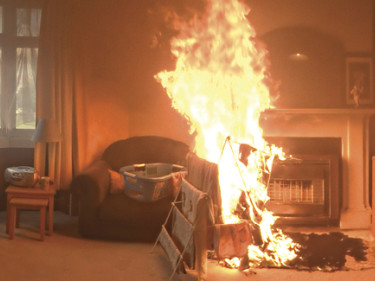If you have a fire extinguisher in your home, you'll be better prepared to put out small fires before they become big ones.
For businesses, please view our commercial advice on fire extinguishers.
Using a fire extinguisher
Only use a fire extinguishers when:
- It's safe to do so considering the size and location of the fire (your extinguisher will only last 10-15 seconds once started).
- You're confident you understand how to use the extinguisher correctly.
- Everyone has been evacuated and accounted for at your safe meeting place.
- Fire and Emergency New Zealand has been called.
- You can safely access and retreat from the fire.
Remember, life is more important than property. Don't put yourself or others at risk.
Operating a fire extinguisher
When operating a fire extinguisher, use the 'PTASS' technique:
- Pull the safety pin or remove the clip.
- Test squirt the extinguisher to make sure it is working.
- Aim the nozzle at the base of the fire from a safe distance. Most extinguishers are designed to be operated from about 2 - 3 metres away.
- Squeeze the handles.
- Sweep the extinguisher from side to side while aiming at the base of the fire.
Installing a fire extinguisher
You should mount fire extinguishers on the wall, out of reach of children.
Place fire extinguishers in noticeable places where they can be accessed safely, such as:
- In or near the kitchen – not too close to the stove or cooking surfaces
- In the garage
- In cars, caravans and boats
Types of fire extinguisher
There are many different types of fire extinguishers:
- Water
- Foam
- Wet chemical
- Dry powder
- Carbon dioxide
- Specialised materials for Class D fires
The type of fire extinguisher you need depends on the class of fire you're most likely to experience.
There are 6 classes of fire:
- Class A (Wood paper plastics)
- Class B (Flammable & combustible liquids)
- Class C (Flammable gases)
- Class D (Fires involving combustible metals)
- Class E (Electrically energised equipment)
- Class F (Cooking oils and fats)
Choosing a fire extinguisher
The most likely type of fire to occur in your home is a cooking oil or fat fire in the kitchen. So if you're buying your first fire extinguisher, you should choose one for the kitchen that is capable of extinguishing Class F fires.
A Wet Chemical extinguisher is best for extinguishing cooking oil and fat fires. This type of extinguisher can also be used on most other classes of fire in the home. However, don't use wet chemical extinguishers on fires with a live electrical source.
While an ABE Dry Powder extinguisher is suitable for other types of fire in your home, you should never use it on a cooking oil or fat fire as the pressure from a dry powder extinguisher will cause the fire to spread.
Ideally, you should protect your home against the widest range of fire hazards with both an ABE Dry Powder extinguisher and a Wet Chemical extinguisher.














